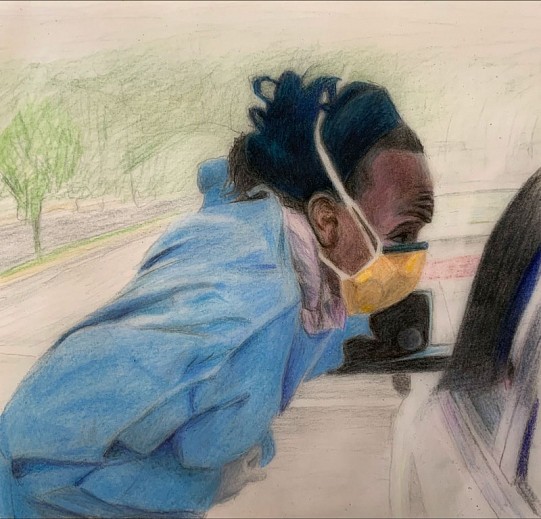
The Brooklyn Rail | Mike Solomon: Artist Stories from the Pandemic
September 9, 2020 - Joyce Beckenstein for The Brooklyn Rail
April Gornik’s seductively realistic, and at times toxically surreal landscape paintings, heighten our angst when we view them from the perspective of today’s coronavirus pandemic. (These days, Gornik finds practical ways to deal with the crisis by making masks and gardening when she’s not painting.) Indeed, one’s new “normal” responses to the acts of looking at and making art are provocative indicators of how our perceptions and behaviors change when circumstances test our resolve. Gornik is one of more than 100 East End, Long Island artists invited by the Parrish Art Museum to contribute a two-minute video to Artist Stories from the Pandemic, an archival project chronicling artists’ response to the COVID-19 crisis.
Corinne Erni, the museum’s Senior Curator of ArtsReach and Special Projects, launched the outreach effort when she saw in this urgent moment a special need to document the continuing legacy of a local art community that dates back to the late 19th-century days of William Merritt Chase. To date, the museum’s website features 51 videos testifying to artists’ personal reactions to this calamitous pandemic. But Erni’s archival project does much more: the short, sometimes breathless clips in this video montage create a poignant exhibition with explicit themes distilling both the agony and unrelenting resilience of artists as they adapt to change.
The predominant theme reflects the impact of the pandemic-ordered “shelter-in-place” directives. While all participants express horror and sadness about the virus, some welcome the imposed isolation as an extension of the seclusion that so many artists traditionally crave. The multi-media artist John Torreano, for example, considers the additional uninterrupted creative time as an opportunity to rework projects. Photographer Mary Ellen Bartley similarly talks of “expansiveness coming from limitations” as she takes us through the quarantine project she began when the virus forced her to return mid-residency from the studio of Giorgio Morandi in Italy to the East End.
Some artists have downsized their practice during sequestration: Donald Lipski “maps the ordeal” with quirky drawings on daily newsprint; Bill Komoski, distanced from his New York studio, makes small works on paper—"exuberant gardens gone haywire”—at his Shinnecock dining room table. Others, such as multimedia artist Allan Wexler, re-examine finished works from a COVID-19 perspective and discover conflated interpretations within them. His Eye Level on a Hill (2015), a sculpture-based ink-jet print featuring human figures atop staircases dispersed on a stark infinite plane, initially symbolized humanity perched on a level field, but dysfunctionally distanced. Today this image simultaneously suggests a cry to communicate and be close. The painter Eric Fischl, on the other hand, interprets his works as he created them in the moment. His recent image of Icarus falling from the sky, unnoticed by anyone, speaks volumes to the callous US government response to a global health catastrophe.
Nature themes abound in these videos, beginning with eco-artist Lillian Ball’s observations about the ways in which the natural world exploits this quiet time to heal itself, and the way people similarly heal through nature, walking within lush, local preserves, coveting the beauty of indigenous habitats. Adam Straus, a long-time denizen of such walks, posits the notion of wildlife reclaiming the landscape with his riveting new series of drawings on New York Times newsprint. For Scott McIntire, whose small, detailed flower paintings and large global landscapes sizzle with symbolic surrounds of “energy fields,” the coronavirus becomes one more invisible particle hovering unpredictably in the air. Video artist Peter Campus, sequestered at home, focuses his lens on his backyard, his ever-discerning eye alert to the beauty of familiar trees as light and wind sail through them.
The pandemic wreaks professional havoc on most everyone. For new media artist Nina Yankowitz, it means she must shrink her new room-sized immersive aquarium projection, celebrating the contributions of 19th-century French marine biologist Jeanne Villepreux-Power, down to a screen-sized, web-based virtual tour. Painter Margaret Garrett, sculptor Hiroyuki Hamada, and others are doing likewise as the virus blankets most gallery and museum exhibitions. It’s an “unhappy moment,” opines Donald Sultan, who warns that this strategy ultimately “leads to false impressions of the original work and a commodification of art.”
At the same time, quarantine has compelled artists to connect with their communities in new ways. Jeremy Dennis, a tribal member of the Shinnecock Indian Nation, is known for his photographs exploring issues of Indigenous identity and cultural assimilation. With exhibits and photoshoots cancelled, he now works with his father to restore the family’s house on the Shinnecock reservation. It will serve as his home, studio and as a communal art space for an artist residency. Roz Dimon works with the Children’s Museum of the East End to bring art to kids within the Latin American community, Zooming with them, and encouraging them to express their fears and joys. But unlike these artists, Mike Solomon had to leave town in February and head to Florida to care for his 102-year-old mom. While there, he met first responders at the Multicultural Health Institute, an organization dedicated to health care for African Americans. The gripping reality of Black physicians risking their lives—first on the pandemic’s front lines, and then again, walking along the street as people of color—moved Solomon to honor them. In a departure from his abstract paintings and sculpture, he has produced a compelling series of pencil drawings, portraits of Black physicians that unfurl the disturbing personal and political imperatives underlying this coronavirus saga.
This evolving archival project hanging on a video grid invites us into artists’ studios, to glimpse their stuff amidst their artworks, to glean the curator’s response to today’s predicament for artists and museums, and to preserve an intimate anthology of artists’ stories during the pandemic.
Back to News
